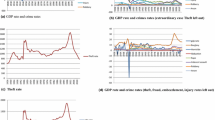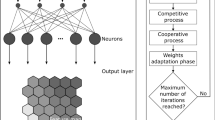Abstract
Modern research on criminal phenomena has been revolving not only around preventing existing offenses, but also around analyzing the criminal phenomena as a whole so as to overcome potential happenings of similar incidents. Criminologists and international law enforcement have been attracted to the cause of examining demographic context on which a crime is likely to arise. Traditionally, little has been explored in using demographic variables as determinants of the aggregate level of crime in the crime literature. Rapid development and ubiquitous application of information technology enables academic field to perform crime analysis using visualization techniques. Automation and networking make it available to access massive amounts of crime data, typically in the form of crime statistics. In numerous fields, studies and research have shown that visualization techniques are valuable; in crime research, nevertheless, there is a general lack of its application. In order to efficiently and effectively process crime data, criminologists and law enforcement are in demand of a more powerful tool. The self-organizing map (SOM), one of the widely used neural network algorithms, may be an appropriate technique for this application. The purpose of this study is to apply the SOM to mapping countries with different situations of crime. A total of 56 countries and 28 variables are included in the study. We found that some roughly definite patterns of crime situation can be identified in traditionally homogeneous countries. In different countries, positive correlation on crime in some countries may have negative correlation in other countries. Overall, correlation of some factors on crime can still be concluded in most groups. Results of the study prove that the SOM can be a new tool for mapping criminal phenomena through processing of large amounts of crime data.








Similar content being viewed by others
References
Abidogun OA (2005) Data mining, fraud detection and mobile telecommunications: call pattern analysis with unsupervised neural networks. PhD thesis, University of the Western Cape, South Africa
Adderley R (2004) The use of data mining techniques in operational crime fighting. In: Proceedings of symposium on intelligence and security informatics no. 2. Tucson A. Z.: ETATS-UNIS (10/06/2004) 3073:418-425
Adderley R, Musgrave P (2003) Modus operandi modelling of group offending: a data-mining case study. Int J Police Sci Manag 5(4):265–276
Adderley R, Townsley M, Bond J (2006) Use of data mining techniques to model crime scene investigator performance. Knowl-Based Syst 20(2):170–176
Axelsson S (2005) Understanding intrusion detection through visualization. PhD thesis, Chalmers University of Technology, Göteborg
Bottoms AE (1976) Criminology and urban sociology. In: Baldwin J, Bottoms AE (eds) The urban criminal: a study in Sheffield. Tavistock Publications, UK, pp 1–35
Braithwaite J, Chapman B, Kapuscinski CA (1992) Unemployment and crime: towards resolving the paradox. Australian National University, Canberra
Brockett PL, Xia X, Derrig RA (1998) Using Kohonen’s self-organizing feature map to uncover automobile bodily injury claims fraud. J Risk Insur 65(2):245–274
Chung W, Chen H, Chaboya LG, O’Toole CD, Atabakhsh H (2005) Evaluating event visualization: a usability study of COPLINK spatio-temporal visualizer. Int J Hum-Comput Stud 62(1):127–157
Clinard MB (1958) Sociology of deviant behaviour. Rinehart & Company, New York
Cressey DR (1964) Delinquency, crime and differential association. Nijhoff, Hague
Dahbur K, Muscarello T (2003) Classification system for serial criminal patterns. Artif Intell Law 11:251–269
Dahmane M, Meunier J (2005) Real-time video surveillance with self-organizing maps. In: Proceedings of the second Canadian conference on computer and robot vision. The University of Victoria, Canada, pp 136–143
Deboeck G (2000) Self-organizing patterns in world poverty using multiple indicators of poverty repression and corruption. Neural Netw World 10:239–254
Dittenbach M, Merkl D, Rauber A (2000) The growing hierarchical self-organizing map. In: Proceedings of the international joint conference on neural networks (IJCNN’2000), Como, Italy, July 24–27, 2000. IEEE Computer Society Press, Los Alamitos, pp VI-15–VI-19
Fei B, Eloff J, Venter H, Olivier M (2005) Exploring data generated by computer forensic tools with self-organising maps. In: Proceedings of the IFIP working group 11.9 on digital forensics, pp 1–15
Fei BK, Eloff JH, Olivier MS, Venter HS (2006) The use of self-organizing maps for anomalous behavior detection in a digital investigation. Forensic Sci Int 162(1–3):33–37
Grosser H, Britos P, García-Martínez R (2005) Detecting fraud in mobile telephony using neural networks. In: Ali M, Esposito F (eds) IEA/AIE 2005, LNAI 3533. Springer, Berlin, pp 613–615
Harries K (2006) Property crimes and violence in United States: an analysis of the influence of population density. Int J Crim Justice Sci 1(2):24–34
Hartung G, Pessoa S (2007) Demographic factors as determinants of crime rates. Retrieved July 10, 2012, from http://www.abep.nepo.unicamp.br/SeminarioPopulacaoPobrezaDesigualdade2007/docs/SemPopPob07_1062.pdf
Hollmén J (2000) User profiling and classification for fraud detection in mobile communications networks. PhD thesis, Helsinki University of Technology, Finland
Hollmén J, Tresp V, Simula O (1999) A self-organizing map for clustering probabilistic models. Artif Neural Netw 470:946–951
Huysmans J, et al (2006) Country corruption analysis with self-organizing maps and support vector machines. In: Chen H et al (eds): WISI 2006, LNCS 3917, pp 104–114
Kangas LJ (2001) Artificial neural network system for classification of offenders in murder and rape cases. The National Institute of Justice, Finland
Koenig S (1962) The immigrants and crime. In: Roucek JS (ed) Sociology of crime. Peter Owen Ltd, London, pp 138–159
Kohonen T (1997) Self-organizing maps. Springer, Berlin
Kohonen T, Honkela T (2007) Kohonen network. Scholarpedia 2(1):1568
Lampinen T, Koivisto H, Honkanen T (2005) Profiling network applications with fuzzy c-means and self-organizing maps. Classif Clust Knowl Discov 4:15–27
Lee S-C, Huang M-J (2002) Applying AI technology and rough set theory for mining association rules to support crime management and fire-fighting resources allocation. J Inf Technol Soc 2:65
Lemaire V, Clérot F (2005) The many faces of a Kohonen map a case study: SOM-based clustering for on-line fraud behavior classification. Classif Clust Knowl Discov 4:1–13
Leufven C (2006) Detecting SSH identity theft in HPC cluster environments using self-organizing maps. Master’s thesis, Linköping University, Sweden
Li S-T, Tsai F-C, Kuo S-C, Cheng Y-C (2006) A knowledge discovery approach to supporting crime prevention. In: Proceedings of the joint conference on information sciences, Taiwan
McGuire M (2005) Effects of density on crime rates in U.S. cities: a modern test of classic Durkheimian theory. Retrieved July 10, 2012, from http://www.sociology.uiowa.edu/mbmcguir/capstone/TRSresearch.doc
Memon Q A, Mehboob S (2006) Crime investigation and analysis using neural nets. In: Proceedings of international joint conference on neural networks, pp 346–350
Oatley GC, Ewart BW, Zeleznikow J (2006) Decision support systems for police: lessons from the application of data mining techniques to “soft” forensic evidence. Artif Intell Law 14(1):35–100
PPIC (Public Policy Institute of California) (2008) Immigrants and crime. Retrieved July 10, 2012, from http://www.ppic.org/content/pubs/jtf/JTF_ImmigrantsCrimeJTF.pdf
Rhodes B, Mahaffey J, Cannady J (2000) Multiple self-organizing maps for intrusion detection. In: Proceedings of the 23rd National information systems security conference. October 16–19, 2000, Baltimore, Maryland, USA
Rock P (1994) History of criminology. Dartmouth, Aldershot
Situngkir H (2003) Merging the emergence sociology: the philosophical framework of agent-based social studies. J Soc Complex. Retrieved July 10, 2012, from http://cogprints.org/3519/1/Soc.pdf
South SJ, Messner SF (2000) Crime and demography: multi linkages, reciprocal relations. Ann Rev Sociol 26:83–106
Sumner C (2005) The social nature of crime and deviance. In: Sumner C (ed) The blackwell companion to criminology. Blackwell, Oxford, pp 3–31
Taft DR (1950) Criminology: a cultural interpretation. The MacMillan Company, New York
The Community Safety and Crime Prevention Council (1996) The root causes of crime—the community safety and crime prevention council statement on the root causes of crime. Waterloo, Canada
Thio S (1978) Deviant behavior. Houghton Mifflin Company, Boston
Wadsworth T (2010) Is immigration responsible for the crime drop? An assessment of the influence of immigration on changes in violent crime between 1990 and 2000. Soc Sci Quart 91(2):531–553
Wirth L (1938) Urbanism as a way of life. Am J Sociol 44(1):1–24
Zaslavsky V, Strizhak A (2006) Credit card fraud detection using self-organizing maps. Inf Secur Int J 18:48–63
Author information
Authors and Affiliations
Corresponding author
Rights and permissions
About this article
Cite this article
Li, X., Juhola, M. Country crime analysis using the self-organizing map, with special regard to demographic factors. AI & Soc 29, 53–68 (2014). https://doi.org/10.1007/s00146-013-0441-7
Received:
Accepted:
Published:
Issue Date:
DOI: https://doi.org/10.1007/s00146-013-0441-7




